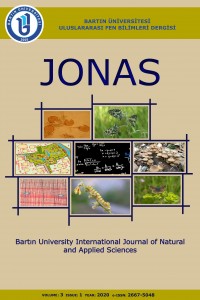Research Article
Year 2020,
Volume: 3 Issue: 1, 11 - 17, 31.07.2020
Abstract
References
- 1. Yıldırım M.M. (1987). Metallurjik katı atıklardan yaralanabilme olanakları, T.M.M.O.B, Metallurji Müh. Odası, 49, 12-15.
- 2. Babu D.S, Babu K.G &Wee TH. (2005). Properties of lightweight expanded polystyrene aggregate concretes containing fly ash. Cement and Concrete Research, 35, 1218-1223.
- 3. Kaya A. & Kar F. (2016). Properties of concrete containing waste expanded polystyrene and natural resin, Construction and Building Materials, 105, 572-578.
- 4. Bicer A. & Kar F. (2017). The effects of apricot resin addition to the light weight concrete with expanded polystyrene, Journal of Adhesion Science and technology, 31(21), 2335-2348.
- 5. Devecioglu A.G. & Bicer Y. (2016). The effects of tragacanth addition on the thermal and mechanical properties of light weight concretes mixed with expanded clay. Period. Polytech. Civil Eng., 60(1), 45-50, 2016.
- 6. Demirel B. (2013). Optimization of the composite brick composed of expanded polystyrene and pumice blocks. Construction and Building Materials, 40, 306-313.
- 7. Al Rim K., Ledhem, A. & Douzane, O. (1999). Dheilly, RM. Queneudec, M.. Influence of the proportion of wood on the thermal and mechanical performances of clay-cement-wood composites. Cement and Concrete Composites, 21, 269-276.
- 8. Benazzouk A., Douzane O., Mezreb K., Laidoudi B. & Queneudec M. (2008). Thermal conductivity of cement composites containing rubber waste particles, Experimental study and modelling. Construction and Building Materials, 22, 573-579.
- 9. Bicer A. & Celik N. (2020). Influence of pine tree resin on thermos-mechanical properties of pumice-cement composites, Cement and Concrete Composites, 112.
- 10. ASTM C. (1985). Standard specification for fly ash and raw or calcined natural pozzolan for use as mineral admixture in Portland cement concrete, ASTM, Philadelphia, ASTM C; 618-685.
- 11. TS 500, (2000). Turkish Standard, Ankara.
- 12. BS 812-109, (1990). Testing aggregates-part 109: methods for determination of moisture content, British Standards Institution 1990.
- 13. Toksoy M. (1988). Thermal conductivity coefficients of industrial materials, Journal of Engineers and Machinery, 347, 12-15.
Year 2020,
Volume: 3 Issue: 1, 11 - 17, 31.07.2020
Abstract
In this study, waste ferrochromium slag is used instead of using natural aggregate, and low density concrete is produced. For this purpose, slag aggregate is mixed with 10%, 30%, 50% and 70% cement to produce samples. The tests applied to the samples show that an increase in slag in the mix decreases thermal conductivity, specific heat capacity and comprehensive and tensile strength while porosity and water absorption capacity increases. If slag aggregated concrete is used for the structural member of a building, i) factory waste ferro chromium slag will be utilized and contributed to economy. ii) The use of slag in building concrete, bricks, briquettes and panel walls will lower the heating expenses and facilitate energy saving.
References
- 1. Yıldırım M.M. (1987). Metallurjik katı atıklardan yaralanabilme olanakları, T.M.M.O.B, Metallurji Müh. Odası, 49, 12-15.
- 2. Babu D.S, Babu K.G &Wee TH. (2005). Properties of lightweight expanded polystyrene aggregate concretes containing fly ash. Cement and Concrete Research, 35, 1218-1223.
- 3. Kaya A. & Kar F. (2016). Properties of concrete containing waste expanded polystyrene and natural resin, Construction and Building Materials, 105, 572-578.
- 4. Bicer A. & Kar F. (2017). The effects of apricot resin addition to the light weight concrete with expanded polystyrene, Journal of Adhesion Science and technology, 31(21), 2335-2348.
- 5. Devecioglu A.G. & Bicer Y. (2016). The effects of tragacanth addition on the thermal and mechanical properties of light weight concretes mixed with expanded clay. Period. Polytech. Civil Eng., 60(1), 45-50, 2016.
- 6. Demirel B. (2013). Optimization of the composite brick composed of expanded polystyrene and pumice blocks. Construction and Building Materials, 40, 306-313.
- 7. Al Rim K., Ledhem, A. & Douzane, O. (1999). Dheilly, RM. Queneudec, M.. Influence of the proportion of wood on the thermal and mechanical performances of clay-cement-wood composites. Cement and Concrete Composites, 21, 269-276.
- 8. Benazzouk A., Douzane O., Mezreb K., Laidoudi B. & Queneudec M. (2008). Thermal conductivity of cement composites containing rubber waste particles, Experimental study and modelling. Construction and Building Materials, 22, 573-579.
- 9. Bicer A. & Celik N. (2020). Influence of pine tree resin on thermos-mechanical properties of pumice-cement composites, Cement and Concrete Composites, 112.
- 10. ASTM C. (1985). Standard specification for fly ash and raw or calcined natural pozzolan for use as mineral admixture in Portland cement concrete, ASTM, Philadelphia, ASTM C; 618-685.
- 11. TS 500, (2000). Turkish Standard, Ankara.
- 12. BS 812-109, (1990). Testing aggregates-part 109: methods for determination of moisture content, British Standards Institution 1990.
- 13. Toksoy M. (1988). Thermal conductivity coefficients of industrial materials, Journal of Engineers and Machinery, 347, 12-15.
There are 13 citations in total.
Details
| Primary Language | English |
|---|---|
| Subjects | Engineering |
| Journal Section | Articles |
| Authors | |
| Publication Date | July 31, 2020 |
| Published in Issue | Year 2020 Volume: 3 Issue: 1 |

